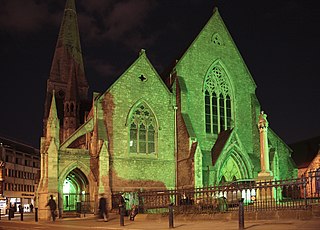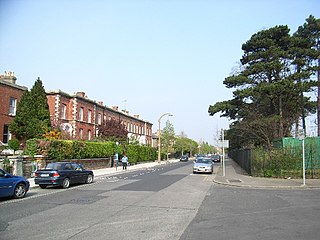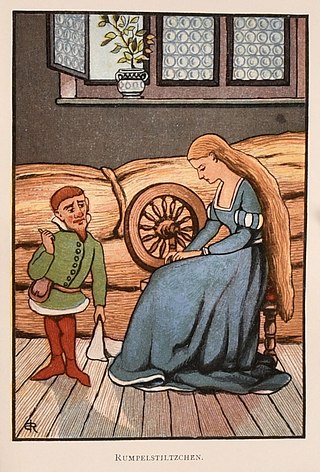
Glendalough is a glacial valley in County Wicklow, Ireland, renowned for an Early Medieval monastic settlement founded in the 6th century by St Kevin. From 1825 to 1957, the head of the Glendalough Valley was the site of a galena lead mine. Glendalough is also a recreational area for picnics, for walking along networks of maintained trails of varying difficulty, and also for rock climbing.

Rathgar is a suburb of Dublin, Ireland. Originally a village, which from 1862 was part of the township of Rathmines and Rathgar, it was absorbed by the growing city and became a suburb in 1930. It lies about three kilometres south of the city centre.

Crumlin is a Southside suburb of Dublin, Ireland. Formerly a rural area, it became heavily built up from the early 20th century onwards. Crumlin is the site of Ireland's largest children's hospital, Our Lady's Children's Hospital.

Walkinstown is a suburb of Dublin in Ireland, six kilometres southwest of the city centre. It is surrounded by Drimnagh to the north, Crumlin to the east, Greenhills to the south, and Ballymount, Bluebell, and Clondalkin to the west. Its postal code is Dublin 12.

Milltown is a suburb and townland on the southside of Dublin, Ireland. Milltown was the site of several working mills on the River Dodder and is also the location of the meeting of the River Slang with the Dodder. It is located adjacent to other suburban areas such as Windy Arbour, Ranelagh, Rathmines, Dartry, Clonskeagh, and Donnybrook.

North Wall is an area east of the inner north side of Dublin, along the River Liffey where it forms one of the Dublin quays.

Michael Geoffrey St Aubyn Jackson is a Church of Ireland Anglican bishop. Since 2011, he has served as the Archbishop of Dublin and Bishop of Glendalough in the Church of Ireland. He is also the co-chairman of the Porvoo Communion of Anglican and Lutheran churches.

The Archdiocese of Dublin is a Latin Church ecclesiastical territory or archdiocese of the Catholic Church located in the eastern part of Ireland. Its archepiscopal see includes the republic's capital city – Dublin. The cathedral church of the archdiocese is St Mary's Pro-Cathedral. Dublin was formally recognised as a metropolitan province in 1152 by the Synod of Kells. Its second archbishop, Lorcán Ua Tuathail, is also its patron saint.

The United Dioceses of Dublin and Glendalough is a diocese of the Church of Ireland in the east of Ireland. It is headed by the Archbishop of Dublin, who is also styled the Primate of Ireland. The diocesan cathedral is Christ Church Cathedral, Dublin.

The R111 road is a regional road in south Dublin, Ireland, and includes a major element of the Dublin Outer Orbital Route.

St. Peter's Church was a former Church of Ireland parish church located in Aungier Street in Dublin, Ireland, where the Dublin YMCA building now stands. It was built on land that formerly belonged to the Whitefriars in Dublin. It served the largest Church of Ireland parish in Dublin.

St Andrew's Church is a former parish church of the Church of Ireland that is located in St Andrew's Street, Dublin, Ireland. After ceasing to be a church, it housed the main Dublin tourist office of Fáilte Ireland until 2014, and later underwent redevelopment with a view to reopening as a food hall.
Joseph Deane PC (1674–1715) was an Irish politician and judge who became Chief Baron of the Irish Exchequer. His sudden and premature death was popularly believed to be due to a chill caught when watching an eclipse of the sun.

An election to Dublin City Council took place on 5 June 2009 as part of that year's Irish local elections. 52 councillors were elected from eleven local electoral areas (LEAs) for a five-year term of office on the electoral system of proportional representation by means of the single transferable vote (PR-STV).

Kenilworth Square is a Victorian square in the Rathgar area of Dublin 6, Ireland. It was developed by several different developers between 1858 and 1879. The houses are in a variety of different styles although all are finished in red brick.

North Strand Church is a Church of Ireland church on North Strand and Waterloo Avenue in Dublin, Ireland. The original church was established in 1786. It is now part of the United Parish of Drumcondra, North Strand, and Saint Barnabas. St. Columba's National School, which was established in 1787, is on the same grounds and affiliated with the church.

North Great George's Street is a street on the Northside of Dublin city first laid out in 1766 which connects Parnell Street with Great Denmark Street. It consists of opposing terraces of 4-storey over basement red-brick Georgian townhouses descending on an increasingly steep gradient from Belvedere House which bookends the street from a perpendicular aspect to the North.

James Edward Rogers was an Irish artist, architect, and book-illustrator whose early career was in Dublin. In 1876 he moved to London, where he is believed to have worked only as an artist.

St. Mary's Church was a Church of Ireland church in Donnybrook, Dublin entered via Anglesea Road.
St Agnes' is a Catholic church in the suburb of Crumlin in Dublin, Ireland. It is in the Roman Catholic parish of Crumlin in the Archdiocese of Dublin. The church, which opened in 1935, is included on the Record of Protected Structures maintained by Dublin City Council.



















